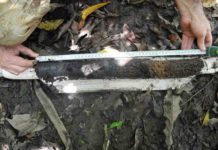Qattara Depression, Egypt
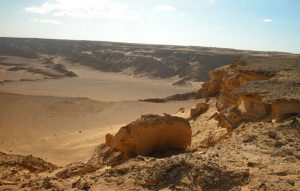
The Qattara Depression is a depression in the north west of Egypt in the Matruh Governorate and is part of the Western Desert. It lies below sea level and is covered with salt pans, sand dunes and salt marshes.
The Qattara Depression contains the second lowest point in Africa at −133 metres (−436 ft) below sea level, the lowest being Lake Assal in Djibouti. The depression covers about 19,605 square kilometres (7,570 sq mi), a size comparable to Lake Ontario or twice as large as Lebanon. Due to its size and proximity to the Mediterranean Sea shore, it has been studied for its potential to generate hydroelectricity.
Umpherston Sinkhole, South Australia

The Umpherston Sinkhole (or the Sunken Garden) is one of the most spectacular gardens located in the Mount Gambier region.
Umpherston sinkhole was once a typical limestone cave that formed by the corrosion of limestone rocks by seawater waves and the sinkhole was naturally created when the chamber’s roof collapsed.
Berezniki, Soviet Russia
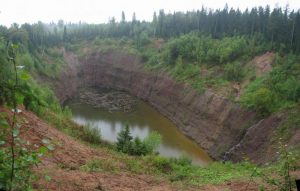
Berezniki and Solikamsk, the second and third largest cities of the Perm Region, sit on abandoned and existing underground potash mines, some of those located as close as 200-300 meters from the surface.
The sinkhole in Berezniki, Soviet Russia began in 1986 as a result of a flooding event in a potash mine and has gradually worsened each passing year. At over 200m deep, 80m long and 40m wide, it is expected to swallow up the only rail line that leads to and from the potash mines, where 10% of the world’s potash used in fertilizer come from.
Guatemala City 2007
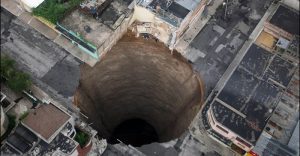
The 2007 Guatemala City sinkhole is a 100-metre deep sinkhole which formed in Guatemala City in 2007, due to sewage pipe ruptures. Its collapse caused the deaths of five people, and the evacuation of over a thousand.
The sinkhole was created by fluid from a sewer eroding uncemented volcanic ash, limestone, and other pyroclastic deposits underlying Guatemala City. The hazards around the pipe have since then been mitigated, by improved handling of the city’s wastewater and runoff,[3] and plans to develop on the site have been proposed.
Guatemala City 2010
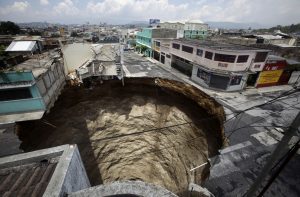
The 2010 Guatemala City sinkhole was a disaster in which an area approximately 65 ft (20 m) across and 300 ft (90 m) deep collapsed in Guatemala City’s Zona 2, swallowing a three-story factory. The sinkhole occurred for a combination of reasons, including Tropical Storm Agatha, the Pacaya Volcano eruption, and leakage from sewer pipes.
Cerro Sarisariñama Sinkholes
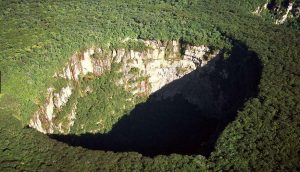
The most distinctive features of Cerro Sarisariñama are its gigantic sinkholes – four in total, with the largest one, called Sima Humboldt, is up to 352 metres wide and 314 metres deep. Down below Sima Humboldt expands to 502 meters wide. The other well known sinkhole Sima Martel is equally impressive at 248 meters deep. Both sinkholes are roughly circular and are located just 700 meters away from each other. The view of these gigantic holes from up the air is quite stunning.
The sinkholes were first discovered in 1961 by pilot Harry Gibson, but the first expedition could only be organized in 1974. The team, consisting of numerous explorers and specialists, descended into the sinkhole with ropes only to realize that getting out was not easy. The sinkhole widens as it goes down making the ropes hang freely.
Bimmah sinkhole, Oman
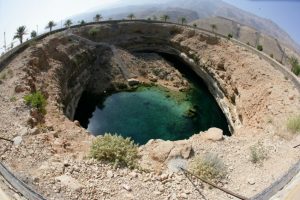
Bimmah Sinkhole (Hawaiyat Najm) is located approximately, one and half hours away from the capital city of Muscat in the Sultanate of Oman. A lake of turquoise waters, 50m by 70 m wide, 20 – 30 m deep and 600m away from the sea, the sinkhole was formed by a collapse of the Earth’s upper crust layer due to erosion.
Devil’s Sinkhole, Texas, USA
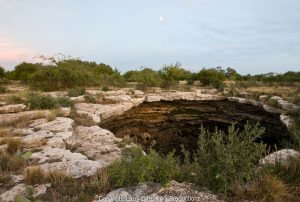
The Devil’s Sinkhole is a vertical natural bat habitat. The 40 by 60 feet (12.2 m × 18.3 m) opening drops down to reveal a cavern some 400 feet (122 m) below. The cavern was first discovered by local residents in 1876. H. S. Barber carved his name inside the cave in 1889. The area was transferred to the state of Texas in 1985, and open to the public in 1992. Carved by water erosion, the cavern is home to several million Mexican free-tailed bats who emerge at sunset during April through October.
Boesmansgat, South Africa
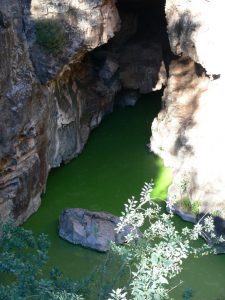
Boesmansgat, also known in English as “Bushman’s Hole”, is believed to be the sixth-deepest submerged freshwater cave (or sinkhole) in the world, having been dived to 282.6 metres (927 ft). It is located in the Northern Cape province of South Africa.
Boesmansgat was believed to have first been explored by amateur diver Mike Rathbourne, in 1977. The greatest depth attained was by Nuno Gomes, in 1996. Its altitude of over 1,500 metres (4,921 ft) makes this a particularly challenging dive, requiring a decompression schedule equivalent for a dive to 339 metres (1,112 ft) feet at sea level. (Gomes’ dive was a close call, as he got stuck in the mud on the bottom of Bushman’s Hole for two minutes before escaping.)
On 24 November 2004, Verna van Schaik set the Guinness Woman’s World Record for the deepest dive with a dive to 221 metres (725 ft).
Agrico Gypsum Stack, Florida,USA
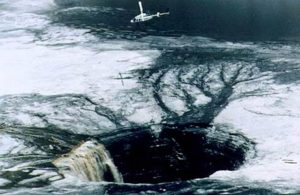
The most devastating sinkhole erosion in Florida occurred in 1994 when a 15-story sinkhole tore open right beneath an 80-million-ton pile of gypsum stack. The cave-in dumped 4 million to 6 million cubic feet of toxic and radioactive gypsum and waste water into the Floridian aquifer, which provides 90 percent of the state’s drinking water.
Daisetta, Texas sinkhole
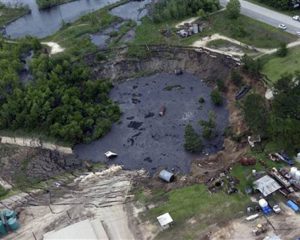
On May 7, 2008, a 20-foot-wide sinkhole in Daisetta, Texas, began swallowing everything in its path and had expanded to 900 feet by the next day with a depth of 260 feet. The former oil town sits on the Hull Salt Dome, a four-mile-in-diameter geologic formation of compacted salt, and geologists speculate that years of storing saltwater waste — a byproduct of oil production — caused the massive pit.
Numby Numby, Australia
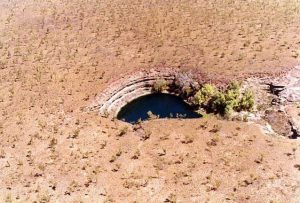
Numby Numby, also known as Nimby Nimby or Ngambingambi, is a sinkhole located 64 to 80 kilometres (40 to 50 mi) from Borroloola in the Northern Territory of Australia.
An underground hot spring feeds into the pit, keeping the water a steady 90 degrees Fahrenheit. The water reaches a depth of about 200 feet almost immediately, and the sinkhole’s shallow waters along its edge are occupied by large lilypads.
The Australian Aborigines believed that Numby Numby was home to evil spirits.
Schmalkalden, Germany

Photograph: Stefan Thomas/AFP/Getty Images
A giant landslide under a residential street takes a car with it and leaves another car hanging over the edge in Schmalkalden, central Germany, on Nov. 1, 2010.
Xiaozhai Tiankeng, China
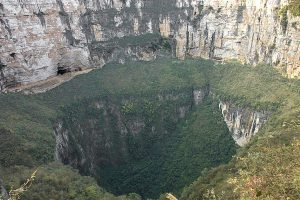
The Xiaozhai Tiankeng, also known as the Heavenly Pit, is the world’s deepest sinkhole. It is located in Fengjie County of Chongqing Municipality.
The Xiaozhai Tiankeng is 626 metres long, 537 metres wide, and between 511 to 662 metres deep, with vertical walls. Its volume is 119,349,000 m³ and the area of its opening is 274,000 m². This material has been dissolved and carried away by the river. The sinkhole is a doubly nested structure—the upper bowl is 320 metres deep, the lower bowl is 342 metres deep, and the two bowls are on average 257 to 268 m across. Between both these steps is a sloping ledge, formed due to soil trapped in the limestone. In the rainy season, a waterfall can be seen at the mouth of the sinkhole.
Picher, Oklahoma sinkhole
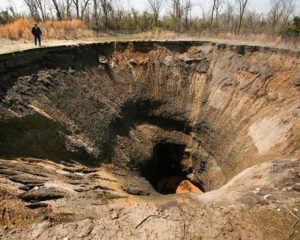
The EPA calls Picher, Okla., the “most toxic place in America,” and today the city is a modern a ghost town. Years of mining for lead and zinc has left the town full of sinkholes like this one. The roofs of some of the mines — unable to support the weight of the earth — collapsed, and now the former municipality is home to only giant chat piles and numerous massive sinkholes.
Cenote Ik Kil, Mexico
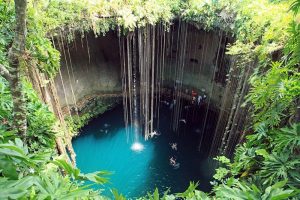
Cenote Ik Kil is a large sinkhole on Mexico’s Yucatan Peninsula that’s sacred to the Mayans. The peninsula’s unique composition of porous limestone has resulted in several of these water-filled sinkholes, but Cenote Ik Kil is one of its most famous.
The hole is 90 feet deep, adorned in tropical vegetation and filled with clear blue water that Mayan royalty used for both relaxation and ritual sacrifices.
El Zacatón sinkhole, Mexico
![The Depthx robot is exploring the waters of El Zacaton, a thousand-foot the sinkhole _ or "cenote" _ in Mexico near the city of Tampico.Illustrates SINKHOLE (category a), by Ceci Connolly, special to The Washington Post. Moved Monday, May 14, 2007. (MUST CREDIT: Courtesy of University of Texas.) [PNG Merlin Archive]](https://www.geologypage.com/wp-content/uploads/2016/11/El-Zacatón-sinkhole-300x276.jpg)
The clear, blue water is highly mineralized and has a sulphurous odor, and it’s quite warm — averaging 86 degrees Fahrenheit. The sinkhole’s name comes from the free-floating islands of zacate grass that blow across the lake in the wind.
Neversink Pit, USA

Neversink Pit is a limestone sinkhole in Alabama, and it’s one of the most-photographed sinkholes in the world because of its beautiful fern-covered ledges and waterfalls. The hole is about 40 feet wide at the top, but it expands to 100 feet at its bottom, which is 162 feet from the ground. Neversink is home to bats and several rare and endangered fern species.
Great Blue Hole
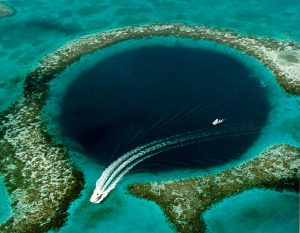
Credit: U.S. Geological Survey (USGS)
The Great Blue Hole is a giant submarine sinkhole off the coast of Belize. It lies near the center of Lighthouse Reef, a small atoll 70 km (43 mi) from the mainland and Belize City. The hole is circular in shape, over 300 m (984 ft) across and 124 m (407 ft) deep.
Dean’s Blue Hole
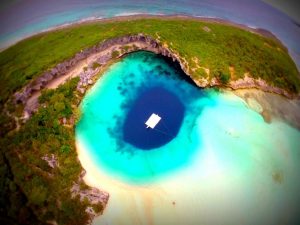
Dean’s Blue Hole is said to be the deepest blue hole in the world, and the second largest underwater chamber. Experts at Reeldivers and Vertical Blue, who have done dives at the site, report that: “It is enclosed on three sides by a natural rock amphitheatre, and on the fourth side by a turquoise lagoon and powder white beach. There is never any swell or waves inside the Hole, and visibility is usually between 50 – 100 feet (15 – 30m).”
Mississippi 2015
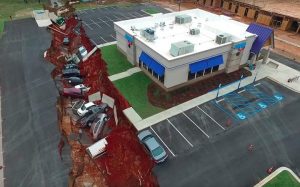
The parking lot at a Meridian, Mississippi, IHOP collapsed Saturday evening, causing 12 cars to tumble into the ground. The 15-foot-deep trench measured 35 feet wide by 400 feet long by the time it finished opening up. No one was injured in the accident.
St Albans 2015

A massive sinkhole has opened up on a street in St Albans, forcing the evacuation of several families from their homes in the night.
The 66ft (20m) diameter hole spread across a front garden and driveway on Fontmell Close and is 33ft (10m) deep.
Hertfordshire County Council said five homes were evacuated and 20 people were taken to a centre set up at the nearby Batchwood Sports Centre.
Residents are said to have heard a crash before the huge crater appeared.
Perm region, Russia
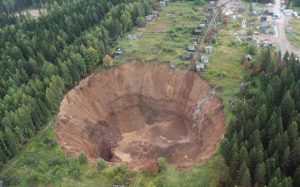
This huge sinkhole in the Perm region of the Urals in Russia is getting bigger and bigger. The hole appeared when a potash mine collapsed at the end of 2014. It now measures 400ft by 410ft (122 metres by 125 metres) and is believed to be more than 246ft (75 metres deep).
Southwest China
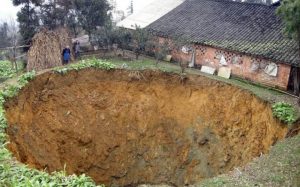
A huge 20-metre wide (66 ft) sinkhole formed overnight in the yard of a family home in Leshan, southwest China’s Sichuan Province in January 2011. Zhang Fengrong said he heard a loud roaring sound coming from outside. When he went to investigate he was stunned to discover the huge pit. He said he and several relatives had tried to measure the depth of the pit using a rope attached to a heavy iron, but after they used up the 40-metre long rope the iron still hadn’t hit ground.








